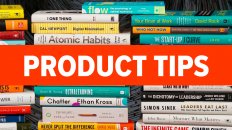One of the most rewarding aspects of life is developing new skills or abilities.
Whether you want to pursue a fun hobby, upgrade your work skills, or change careers entirely, learning something new can be challenging and fulfilling.
Of course, success is never guaranteed. Many people eventually give up on their goals due to unforeseen challenges, obstacles, or setbacks. And to make matters worse, the negative experience can cause them to avoid future opportunities for growth.
Fortunately, learning is a skill like any other. By adopting best practices and avoiding common mistakes, we can improve our ability to acquire new skills. So, today, we’re going to explore seven proven tips for learning a new skill quickly and effectively.
Tip #1: Narrow The Scope To Accelerate Progress
The first priority is getting clear about exactly what you plan to learn.
For example, if you’ve decided to learn a new language, it’s important to be specific about why that skill is important and how you intend to use it. Ask yourself, can you get away with simply speaking the language? Is it necessary to learn how to read and write, or can that come later?
A common mistake is taking on too much at once in the name of “efficiency.”
In the case of learning a language, it’s considerably more challenging to pursue reading, writing, and speaking at the same time. It might seem like a minor increase in effort to combine them into one step, but the added complexity is far more likely to kill your momentum and cause you to quit.
So, regardless of your goal, it’s critical to find ways to narrow the scope.
It’s easier to create progress, build momentum, and ultimately achieve success when you keep things simple. Later, after you have completed your initial goal, you always have the option to layer on related skills and abilities. For example, once you can speak a language, that knowledge is very helpful for developing the ability to read and write.
Tip #2: Prioritize Direct Experience Early And Often
A critical aspect of skill development is gaining experience in the situation or context that you plan to apply the skill.
If you want to learn to code mobile apps, find a way to start working directly on simple apps as early as possible. If you want to learn a sport like basketball, aim to join a pickup game sooner rather than later. If you want to speak a new language, look for opportunities to engage in basic conversations with a native speaker.
This direct approach is in stark contrast to how many things are taught today.
Much of what people learn in classrooms or online courses is abstracted away from real-world situations. Students study facts, concepts, and other information without having a practical way to use what they’ve learned. Likewise, new skills are often taught in simplified, isolated environments.
As Ultralearning author Scott H. Young explains,
“…directly learning the thing we want feels too uncomfortable, boring, or frustrating, so we settle for some book, lecture, or app, hoping it will eventually make us better at the real thing.”
Unfortunately, this approach fails to address one of the most significant challenges in personal development, which is the problem of “transfer.” Transfer is what happens when you learn something in one context, such as shooting a basketball in a driveway, and then use it in another context, such as playing a real game.
The problem is that experience in one context often fails to translate well into another. It’s one thing for a basketball player to make shot after shot in a controlled, familiar environment. It’s another to take a similar shot in a new environment, in the face of a strong defender, after receiving an awkward pass, while being tired from running up and down the court.
A great way to avoid the problem of transfer is to participate in the goal activity as early and as often as possible. Rather than focusing exclusively on isolated skill-building, look for opportunities to “get in the game” on a regular basis. This kind of direct experience makes it easier to identify skills worth practicing while also providing an environment to apply those skills as they are developed.
Note: This may not be an option for every pursuit. Some activities may be too complex, difficult, or dangerous to dive right into. However, the ultimate goal should be to close this gap as quickly as possible. That way, you can apply what you are learning and avoid falling into the trap of focusing exclusively on isolated practice.
Tip #3: Address Weaknesses Through Focused Practice
As you gain direct experience, you will inevitably run into challenges or setbacks that cannot be addressed with your current abilities.
For example, when learning a language, you might start by using flashcards to memorize basic conversational phrases. Then, when conversing with a native speaker to gain practical experience, you may discover that some of the phrases are not commonly used. Furthermore, you may encounter a few new phrases. While this can be frustrating, such experiences provide a clear direction for further improvement.
Your next practice session might involve removing uncommon words from your flashcards and adding new phrases in anticipation of the next conversation with a native speaker.
Scott H. Young calls this the “direct-then-drill” approach. Direct experience provides the foundation for further study. But, once a weakness has been identified, it’s time to “drill” the relevant skills or knowledge in focused practice sessions.
At every step along the way, it’s essential to return to the goal activity to apply what has been learned and get a refined sense of what to work on next. This may seem obvious to some, but it’s easy to fall into the trap of focusing entirely on isolated practice, mistakenly assuming it’s the fastest way to improve.
However, isolated practice needs to be balanced out with integrated learning.
The “direct-then-drill” approach can be applied to almost any pursuit, such as starting a business, writing a book, or even learning an instrument. In each case, the foundation is the same. Everything begins by finding the most direct opportunity to engage in the goal activity. Then, as setbacks or challenges arise, it’s time to engage in purposeful practice to develop or improve skills that seem helpful along the way.
Tip #4: Seek Out Qualified, Actionable Feedback
Regardless of what you are seeking to learn, feedback plays a critical role. It can make all the difference in catching mistakes early, adopting best practices, and avoiding stalled progress. Therefore, it is essential that you create situations where your progress can be routinely observed by a qualified teacher, mentor, or coach.
Now, it’s worth noting that not all feedback is helpful or productive. Blind praise or sharp criticism, such as “you’re smart” or “you’re lazy,” is most often harmful. That’s because it’s directed at you as a person rather than your performance.
The best feedback is that which addresses current mistakes and guides future action. This kind of feedback should detail what you are doing wrong and how to fix it. More often than not, this requires a qualified coach or teacher with deep subject matter expertise and a history of successfully guiding others through the same process.
Of course, direct experience provides some level of feedback as well. However, external input from a coach will allow for much more rapid advancement. Therefore, if you are serious about making progress, it’s best to put yourself in situations where you can receive such feedback on a regular basis.
Beyond simple corrective feedback, another powerful resource is what Scott H. Young defines as “metafeedback.” As he explains,
“This kind of feedback isn’t about your performance but about evaluating the overall success of the strategy you’re using to learn.”
In other words, rather than identifying specific mistakes you may be making, this feedback addresses the overarching approach you’re using to learn. For example, learning a new language using a mobile app may be inferior to using flashcards.
Naturally, there will be situations where it’s impossible to find subject matter experts. Emerging hobbies or interests may be so new as to not yet have qualified teachers or coaches. In such situations, it can be beneficial to gather feedback from non-experts.
As a general rule, it’s easier for an outside observer to accurately assess mistakes or areas for improvement. But, with that said, their suggestions for correcting the mistakes should always be taken with a grain of salt because it’s easier for non-experts to identify problems than to come up with correct solutions.
Tip #5: Build On The Experience Of Top Experts
Some pursuits can and should be more structured than others.
For example, when it comes to learning to play piano at an expert level, there is a clear sense of the order in which techniques and concepts should be introduced. The same is true of many other well-understood pursuits, such as playing professional sports, mastering games like chess, or preparing for Olympic-level competitions.
In such cases, time has allowed for learning methods to be refined over multiple generations. Experienced coaches can then help students build on what worked in the past, avoid common mistakes, and push things to the next level. This is one reason why experts in many domains continually outperform the previous generation. The training methods are constantly being improved, which allows students to perform better.
With that said, many pursuits lack history or structure. In such cases, it’s best to study the top experts or best performers and determine what they have done to become so effective. Dig deep and seek to learn as much as possible about their life experience, related hobbies, or other factors that may have played a role in their success. Then use what you have learned to develop training methods for reproducing their results.
Tip #6: Understand The Fundamentals Deeply
Another key to effective learning is understanding the basics on a deep level.
This often involves digging beneath best practices and surface knowledge to better understand how and why things work the way they do. In other words, instead of just memorizing rules-based processes for getting things done, seek to understand how the procedures work and why they were established in the first place.
When we understand something on a deep level, we can apply the knowledge to a wider variety of situations, recall details with greater accuracy, and learn related concepts faster.
Consider the difference between memorizing complex directions to several restaurants in a new city versus truly understanding the lay of the land. When someone has deep knowledge about a city, they don’t have to memorize turn-by-turn directions for every new destination they want to visit. Instead, they can link new destinations with existing knowledge, recall relevant landmarks, and add them to their mental map.
In my experience, many so-called “professionals” rely heavily on predefined processes or formulas to get things done. As a result, even minor changes in their workflow can be a cause for panic because they lack the deep knowledge required to adapt on the fly. To make matters worse, much of their experience isn’t transferable to a new job due to being built on processes and protocols that are highly situational.
To be clear, it’s crucial to adopt and follow best practices, especially when first starting to explore a new area of interest. However, as your knowledge deepens, you should avoid relying on processes or formulas as a crutch. Instead, seek to understand how things really work and why best practices were adopted in the first place.
Not only can this approach help you identify when a process is flawed or outdated, but it can also help you understand when it makes sense to break away from the rules and improvise to create superior results.
When in doubt, ask yourself questions like:
- Why are things done that way?
- Is that still the best approach today?
- What else might work better?
Tip #7: Rely On Habits Instead Of Willpower
In my experience, well-designed habits provide the single greatest point of leverage for effective learning and positive change.
No amount of willpower or motivation can compete with the progress that results from consistent action over an extended period. As author James Clear explains,“You do not rise to the level of your goals. You fall to the level of your systems.” Thus, it’s essential that we carve out time to focus on the things that matter most.
My favorite strategy for building new habits is to anchor them to existing routines. As social scientist BJ Fogg explains, “You already have a lot of reliable routines, and each of them can serve as an Action Prompt for a new habit.” He goes on to explain, “to create a new habit, you need to find what behavior it should come after.”
For example, you might choose to build a habit that occurs either after your morning shower, when you return home from work, or after cleaning up the dishes in the evening. The right choice will depend on various factors, but one crucial thing to consider is the frequency of the existing routine. If you want to develop a habit of writing for 30 minutes each day, for example, you’ll want to attach that habit to another routine that already takes place daily.
Another thing to consider is that certain parts of the day may be more predictable than others. Personally, I find it easier to add new habits to my morning routine, even if that means waking up a little earlier. My evening schedule is more prone to last-minute changes or unscheduled disruptions. So, with this in mind, consider the aspects of your routine that are more predictable on a daily basis. Then, look for ways to incorporate new habits within those windows of time.
If you’re interested in learning more about building positive habits or breaking bad ones, I recommend reading Tiny Habits by BJ Fogg or Atomic Habits by James Clear.
Do You Have A Question Or Comment?
Visit how to learn any new skill quickly and effectively video on YouTube to share your thoughts in the comment section. You may also be interested in subscribing to the Rick Kettner YouTube channel or the Rick Kettner podcast, so you don’t miss future content.


